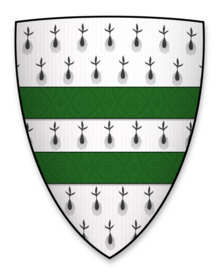William de Lanvallei
William de Lanvallei (also Lanvalei or Lanvaley) (* before 1190, † around 1216) was an English nobleman. He belonged to the aristocratic opposition that forced King John Ohneland to recognize the Magna Carta.
origin
Lanvallei came from a noble family that had risen to serve the king under King Henry II . After the English King Henry II. In 1166 and Duke of Brittany had become, he had the same name Williams grandfather William de Lanvallei I to Seneschal of Rennes appointed. 1171 or 1172 William de Lanvallei moved to England and served the king as castellan of Winchester and in other offices. By the favor of the king he was allowed to marry Gunnora, the daughter and heiress of Hubert de St Clair , through which he came into the possession of the Walkern rule in Hertfordshire . William I died in 1181, his heir became his son William de Lanvalei II, who married Hawise de Bocland. His heir became his eldest son from that marriage, William de Lanvallei III, who was born before 1190.
Life
William de Lanvallei III was still a minor when his father died in 1204. After he came of age, he sought to regain control of the royal Colchester Castle in Essex , which his father had received from King Richard the Lionheart in the 1190s , but which had returned to the King after his mother's death in 1209. In 1214 Lanvallei took part in the unsuccessful campaign of King John in Poitou and was present in September at the armistice that the king had to conclude with France in September. After his return to England he joined the aristocratic opposition to the king. The connection to this could have come about through the leader of the aristocratic opposition Robert FitzWalter , because his wife's mother was his niece. He was also related to Geoffrey de Mandeville . After the King's recognition of the Magna Carta in June 1215, Lanvallei was elected one of the 25 barons who were to oversee the King's compliance with the Magna Carta. In July 1215, the king returned the administration of Colchester Castle to him, but when the king revoked his recognition of the Magna Carta in the autumn, the barons waged open war against the king. Lanvallei remained on the side of the king's opponents. In July 1216 he was also confirmed by the rebels as administrator of Colchester Castle, but died a little later.
Marriage and inheritance
Lanvallei had married Maud Peche, with whom he had a daughter who became his heiress:
- Hawise
The guardianship of his daughter took over the later royal legal counsel Hubert de Burgh , who married her to his son John. With that the lands of the Lanvalleis fell to the de Burgh family.
In the parish church of Walkern there is a grave monument depicting a knight. The funerary monument was probably built from Purbeck marble between 1240 and 1250 and could represent William de Lanvallei or his son-in-law John de Burgh.
literature
- Peter Sinclair: Medieval Walkern and Magna Carta . Wakern History Society 2013, ISBN 978-0-9576286-0-1
Web links
- Nigel Saul: Magna Carta 800th: William de Lanvallei
- William III de Lanvaley on thepeerage.com , accessed December 20, 2015.
Individual evidence
- ^ Matthew Strickland: Enforcers of Magna Carta (act. 1215–1216) (Oxford Dictionary of National Biography, license required). Retrieved December 21, 2015 .
- ^ Walkern History Society: Effigy of William de Lanvalei. Retrieved December 21, 2015 .
| personal data | |
|---|---|
| SURNAME | William de Lanvallei |
| ALTERNATIVE NAMES | William de Lanvalei; William de Lanvaley |
| BRIEF DESCRIPTION | English nobleman |
| DATE OF BIRTH | before 1190 |
| DATE OF DEATH | after July 1216 |
